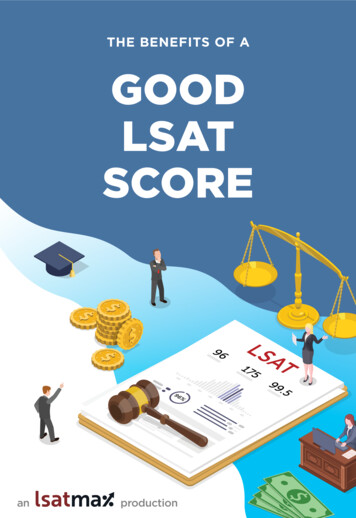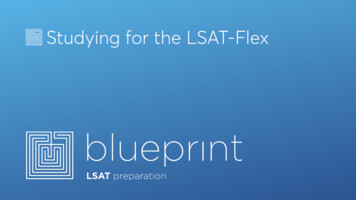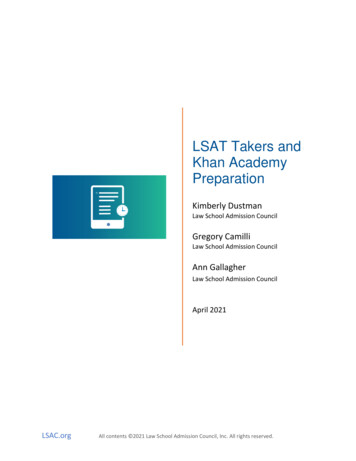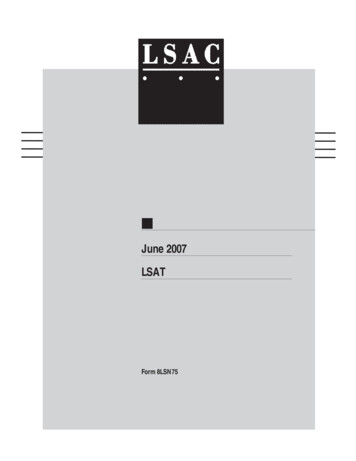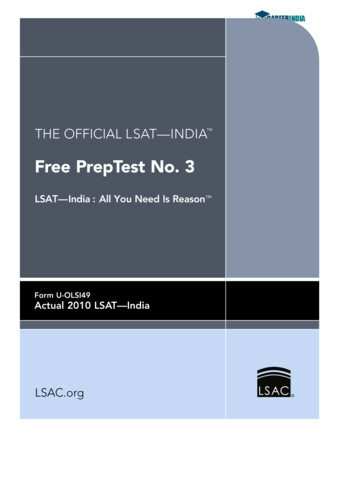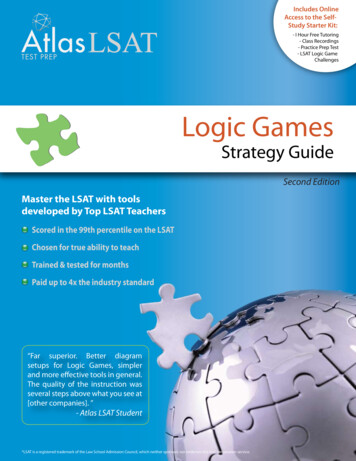
Transcription
THE ROADTO 180COMPREHENSIVE LSAT PREPON MOBILE & WEBtestmaxprep.com
Copyright 2019The Road to 180 – The Ultimate Guide to LSAT PrepPublished by TestMax, Inc.http://testmaxprep.comNo part of this publication may be reproduced, stored in a retrievalsystem or transmitted in any form or by any means, electronic,mechanical, photocopying, recording or otherwise, without priorpermission of TestMax.For information about permissions or to request permissions, call(855) 483-7862.ISBN-13: 9781733458900ISBN-10: 1-7334589-0-5All rights reserved.For information regarding permission, write to:TestMax555 Rose Ave #GVenice, CA 90291Disclaimer: LSAT is a registered trademark of Law School AdmissionCouncil. LSAC does not review or endorse specific test preparationmaterials or services.
Simulate the experience of thedigital LSAT on every prep test.TAKE A SIMULATED DIGITALLSAT FOR FREE.Real Questions OnlyDetailed Analytics87 Full Length LSATsMessage BoardsAuthentic Digital LSATExperienceNo Internet RequiredPractice LSATs
Want a high level of personalizedattention from to best of the best?GET LIVE ONE-ON-ONEATTENTION FROM 99THPERCENTILE TUTORS.visit testmaxprep.com/lsat/tutoring
Want to get insights about lawschool admissions and the LSAT?SUBSCRIBE TO OURINSIDER CONTENT SERIESWITH MEHRAN.Instagram LiveSessionsThe Legal LevelPodcast@lsatmaxon iTunesvisit testmaxprep.com/lsat/insider
LONG IS THE WAY, ANDHARD, THAT OUT OF HELLLEADS UP TO LIGHT.John Milton
TABLE OFCONTENTSIntroduction. VCOMMONLY ASKED QUESTIONS1.What Is the LSAT?. 12.When Can I Take the LSAT?. 183.What is a good LSAT Score?. 214.What is the Best Way to Prepare for the LSAT?. 245.Should I Take LSAT Prep Course?. 286.Are There Any Classes in UndergradThat Will Help Me With the LSAT?. 327.How Do I Improve My Timing?. 348.How Long Should I Study for the LSAT?.379.How Many Practice LSATs Should I Take?. 4110. Should I Cancel My LSAT Score?. 42
QUESTIONS YOU SHOULD ASK1.Are You Preparing With Real Questions?. 452.Is Law School For Me?. 483.What Happens if I Don’t Get the Score I Want?. 554.How Can I Mentally and Physically Prepare for the LSAT?. 595.When Should I Take the LSAT?. 666.Who is My Instructor?. 697.Which Test Center Should I choose?.728.What Can I Do Outside of My LSAT Prep That WillHelp My Score?. 779.Are There Any Benefits to an In-Class Prep Course?.7910. Why is My LSAT Prep Course So Expensive?. 82Conclusion. 85
INTRODUCTIONCongratulations! You have taken the first step indeciding to go to law school. Whether you arejust starting to prep for the LSAT or you are trying tomaximize your LSAT score, we understand your struggle.We’ve been there!LSATMax was created because our founder, MehranEbadolahi, realized while studying for the LSAT thattraditional in-class LSAT courses did not provide the toolshe needed to maximize his score. When Mehran’s in-classcourse ended and his access to the course materials wasdiscontinued, he was nowhere near his target score sohe decided to postpone his exam date and self-study fora few more months. He eventually raised his score by 26points, scoring a 174 on the December 2004 LSAT, andgained admission to Harvard Law School.During his time at Harvard, he decided to fix theproblems he saw in test prep. After creating BarMax, onev
of the top bar exam review courses available, he movedon to create LSATMax, the first comprehensive LSATcourse available in the App Store. LSATMax was createdto give all students access to high-quality LSAT prep atan affordable price. We feel that everyone should havethe opportunity to get the highest possible score on theLSAT, particularly since the LSAT is by far the number onefactor in law school admissions.When Mehran first decided to pursue law school andtake the LSAT, he was completely lost. In fact, he walkedout of his first practice LSAT seriously reconsidering hislaw school dream. He had many questions and neededguidance, but had no single, dedicated place to turn foranswers.Enter this book. In order to combat the daunting andconfusing task of beginning (or continuing) your LSATprep, we have created a list of the top ten frequentlyasked LSAT questions (i.e., Commonly Asked Questions)and the top ten “should-ask” LSAT questions (i.e.,Questions You Should Ask). In this book, we provide theanswers to those questions.Take a deep breath. We’ve got your back.The road to 180 starts here.vi
12COMMONLYASKEDQUESTIONS
1What Is The LSAT?The Law School Admission Test (LSAT) is a half-daystandardized test that is administered multiple timeseach year at designated testing centers throughout theworld. The test is an integral part of the law schooladmission process in the United States, Canada, anda growing number of other countries, making up 7580% of the admissions decision. It provides a standardmeasure of acquired reading and reasoning skillsthat law schools use as the main factor in comparingapplicants.LSAT Format OverviewThe LSAT consists of five 35-minute sections ofmultiple-choice questions, four of which contribute to
2your score. The unscored section, commonly referredto as the experimental section, is used to pretest newLSAT questions. The placement of this section will nowvary because, as of October 2011, LSAC removed theprevious rule that required the experimental section toappear in the first three sections (i.e., before the break).A 35-minute writing sample used to be administered atthe end of the fifth section but, as of June 2019, you willnow complete the writing sample online at a time andplace of your choosing. You will be able to take LSATWriting on the day of your LSAT administration andfor up to one year thereafter. LSAC does not score thewriting sample, but a copy of the writing sample will besent to all law schools to which you apply.Historically, the LSAT has been a paper-and-pencil test.This is still the case for international LSATs, at leastfor the time being. In the United States and Canada,however, the LSAT is now a digital exam administered ona Microsoft Surface Go tablet.Tablets will be provided to test takers at the test center.On the digital LSAT, both the content and the structureof the test sections and the questions will be the same asthe paper-and-pencil LSAT. But in addition, the digitalLSAT will include new features such as a timer witha five-minute warning, highlighting, underlining and
3flagging to keep track of questions that you may want torevisit in a section.While this is undoubtedly the biggest in change inhistory of the LSAT, tablet-based digital LSATs arenothing new for LSATMax. We have been offeringfull-length, officially licensed LSATs on both iPads andAndroid tablets since 2012, so you can rest assured thatour 5-star rated app will allow you to simulate the newdigital LSAT experience on every official Prep Test.Available in the App Storesand testmaxprep.com
4In addition to the LSATMax app, you can also simulatethe digital LSAT experience on iPads and Android tabletsusing our newest app, Practice LSATs by LSATMax.Practice LSATsAvailable in These App Stores
5Logic GamesEvery Logic Games (aka Analytic Reasoning) sectionconsists of 22-25 questions with 4 different games,each containing anywhere from 5 to 8 questions. Thesequestions measure your ability to understand a structureof relationships and then draw logical conclusions aboutthat structure. You are asked to reason deductively, usinga set of statements and rules that describe relationshipsamong people, things, or events.Analytical Reasoning questions reflect the kinds ofcomplex analyses that a law student performs in thecourse of legal problem-solving. As with all other typesof questions on the LSAT, there is a finite number of“types” of questions. All Logic Game questions will havesome type of inventory, whether it’s people, canoes,apples, or wombats. You are then asked to place theinventory in some type of order: sequential, grouped, orjust based upon the sometimes‑convoluted conditionsthat the LSAC will give you. Really, Logic Games areno different than a Sudoku puzzle, and the great thingabout the games is that they are actually easier thanSudoku. After you have seen a few hundred questions,they will become familiar—even predictable. One veryimportant thing to remember about the LSAT is that it isrepetitive.
6Your goal is to come up with a system to draw out asetup and symbols that depict the rules you’re given. Itis essential to develop a setup and rule diagrams thatcorrectly reflect the conditions; in turn, this will allowyou to move through each question accurately andefficiently. Once you have your rules written down, youwill want to plug them back into your setup.For example, a Logic Games question could presentthe following scenario: six bloggers—Jake, Karla, Laith,Melody, Neema, and Olivia—are standing in line, onein front of the other, to purchase tickets to see theAvengers: Endgame. The conditions could be as follows:1) Jake is in front of Melody, 2) Karla is in front of Olivia,3) Jake is not in front of Neema, and so forth.In creating your rule diagrams, you would depictcondition #1 like this: J M. The great thing aboutthe games is that you can use whatever symbols youwant, and arrange them the way you like best—so longas you are CONSISTENT! Let’s try condition #2: K O.Now let’s go for #3: your first instinct may be to write“not J N.” However, it is always best to write out yoursymbols, if possible, in the positive. So, let’s think. Ifall six bloggers are in line, and Jake is NOT in front ofNeema, then Neema is in front of Jake, right? Right! Sowe would write it out as such: N J. Bravo!
7Logical ReasoningWhile there is only one scored Logic Games sectionand one scored Reading Comprehension section on theLSAT, there are two scored Logical Reasoning sections.Therefore, 50% of your score is Logical Reasoning.Each section has anywhere from 24 to 26 questions.These questions assess your ability to analyze, criticallyevaluate, and complete arguments as they occur inordinary language. Each Logical Reasoning questionrequires you to read and comprehend a short passage(aka the stimulus), then answer a question about it. Thequestions are designed to assess a wide range of skillsinvolved in critical thinking, with emphasis on the skillscentral to legal reasoning. These include the ability todraw well-supported conclusions, the ability to reasonby analogy, and the ability to determine how additionalevidence affects an argument, all while applying definedprinciples or rules and identifying logical fallacies.Most stimuli presented in this section are arguments,which consist of two main parts: the premises (i.e.,the evidence or support) and the conclusion. Usually,some scientist or spokesperson is drawing a ridiculousconclusion based upon evidence that is not necessarilyconnected to (or supportive of) that specific conclusion.
8You might see, for instance, something like, “Naz likesonly delicious foods. All red apples are delicious.Therefore, Naz likes red apples.” Here, the speaker hasarrived at the incorrect conclusion that just because Nazonly likes delicious foods, and red apples are delicious,Naz must like red apples. What assumption has thespeaker made? The speaker has assumed that Naz likesall delicious foods, which must then include red apples.In fact, however, a food must be delicious for Naz to likeit, but just because it is delicious does not necessarilymean she will like it. To put this in terms you will soonbe very familiar with, the delicious quality of a food isnecessary, but not sufficient, for Naz to like it.A very important thing to keep in mind while in thissection (and, for that matter, in all LSAT sections) is thatthe words you see in the stimulus are your world. If, forinstance, the stimulus says, “William Shakespeare wroteDeath of a Salesman,” then no matter how egregious theerror, you must take it at face value and begrudginglymove forward. The words in the question are your world,and you know nothing beyond that stimulus for thepurposes of this exam.Now, back to our “red apple” example. The speaker hasincorrectly assumed that just because Naz likes onlydelicious foods, she has to like all delicious foods. But,
9according to the evidence presented in the stimulus,this is not necessarily true. The premise—Naz likes onlydelicious foods—actually leaves open the possibilitythat Naz could dislike certain delicious foods, includingred apples; this possibility destroys the validity of theconclusion.Here is another important thing to remember: althoughyou should never question the evidence that is givento you, you must always question the link between thatevidence and the conclusion. For example, let’s look atthe following stimulus: “Recent studies have shown thatsome male giraffes have blue tongues. Therefore, somefemale giraffes must also have blue tongues.” You shouldnot question the evidence (i.e., that recent studies ofmale giraffes have taken place). Accept as fact that recentstudies have shown that there are some male giraffeswith blue-colored tongues. But you absolutely mustquestion the conclusion by asking what evidence aboutmale giraffes has to do with female giraffes.Remember, the LSAT is very repetitive. There are about16 variations of question types on the Logical Reasoningportion. Learn the specific skill and technique for eachquestion type; then, all you have to do is identify thequestion type and apply the respective technique to findthe correct answer. Practice is key.
10Reading ComprehensionEach Reading Comprehension section consists of 4passages, each of roughly 400-500 words. You willreceive 3 solitary passages and 1 comparative passage.Each passage is followed by 5 to 8 questions for a total of25-28 questions. These questions measure your ability toread and comprehend examples of lengthy and complexmaterials similar to those you will commonly encounter inlaw school.There is always one passage on the arts or literature (thehumanities), one passage on the natural sciences, onepassage on the social sciences, and one passage on a topicrelated to law. You will be asked to identify the author’smain point, tone, and purpose. You will have to makeinferences based upon the information you have read, andpinpoint specific information found in the passage.The first hurdle you must face is understanding that it isnot the questions that are stumping you—it is that youmay not be used to reading annoyingly dense articles veryquickly, and actually absorbing the information presented(particularly when you have zero interest in the subjectmatter!).It is all about the main point, the tone, and the purpose.After you read each passage, stop for a second and
11answer these three questions:(1) What was the passage about?(2) How was the information conveyed to the reader?(3) Why was the information conveyed to thereader? (e.g., to right a misconception, to inform, topersuade, etc.)The answers to these three questions will help youtame the Reading Comprehension section. Get usedto knowing the what, how, and why of each passage.You will soon see how great an asset this informationcan be. The not-so-secret secret about the ReadingComprehension section is that almost every question isa Must Be True question. This means that every correctanswer is based on a corresponding line (or lines) in thepassage. Practice finding these “liners” for each question,and soon you will see that the correct answers are right infront of you!Writing SectionThe very last section of the LSAT is the Writing Section,which is ungraded.The writing section will now be separate from the LSATand administered on a secure online platform. This
12change will result in greater convenience and flexibilityfor you as the testing day will be shorter, the essay will betyped rather than handwritten, and it can be completedat a time and place of your choosing. Students who sit foran official LSAT will be automatically eligible to completethe writing section as of the date of the LSAT and upto one year thereafter. You are only required to haveone essay on file to complete your Law School Reports.Essays completed during previous LSAT administrationswill still be valid for use in Law School Reports.The Writing Section includes a prompt that describesa situation in which you need to make a decision. Theprompt is never something controversial, so it will bean easy decision. There will be two options, and eachone has pros and cons. There is no right answer. Forexample, you might get something like this:BLZ Stores, an established men’s clothing retailerwith a chain of stores in a major metropolitan area, isselecting a plan for expansion. Using the facts below,write an essay in which you argue for one of thefollowing plans over the other, based on the followingtwo criteria:The company wants to increase its profits.The company wants to ensure its long-term financial
13stability.The “national plan” is to open a large number of men’sclothing stores throughout the country over a shortperiod of time. In doing this, the company wouldincur considerable debt. It would also have to greatlyincrease staff and develop national marketing anddistribution capabilities. Many regional companiesthat adopted this strategy increased their profitsdramatically. A greater number tried and failed,suffering severe financial consequences. BLZ is notwell known outside its home area. Research indicatesthat the BLZ name is viewed positively by those whoknow it. National clothing chains can offer lowerprices because of their greater buying power. BLZcurrently faces increasingly heavy competition in itshome region from such chains.The “regional plan” is to increase the number and sizeof stores in the company’s home region and upgradetheir facilities, product quality, and service. Thiscould be achieved, for the most part, with existing cashreserves. These upgrades would generally increase theprices that BLZ charges. In one trial store in whichsuch changes were implemented, sales and profitshave increased. The local population is growing.BLZ enjoys strong customer loyalty. Regional
14expansion could be accomplished primarily usingBLZ’s experienced and loyal staff, and would allowcontinued reliance on known and trusted suppliers,contractors, and other business connections.Again: there is no correct answer, so all you have to do ischoose the option that tickles your fancy the most; then,argue for the option you chose and against the optionyou did not. This is not the time to be creative or thinkoutside of the box. That means you should not chooseboth options, or make up a third option.Do not stress out about this section. Just complete itto the best of your ability, and hopefully, you will bedone with the LSAT forever. During your LSAT prep,we recommend glancing at a Writing Section promptonce or twice, but there is no need to try your hand at“taking” a Writing Section. For many students, the firsttime they ever see a Writing Section is on their actualLSAT. A lot of law school admissions boards disregard thewriting sample. Of the 157 schools that LSAC surveyed,25.3% reported that they seldom used the writing samplein their decision, and 32.7% responded that they onlyoccasionally used the writing sample.How, exactly, should you write it? Well, remember thatrote, five‑paragraph, argumentative essay structure
15you learned way back in middle school? There was anintroductory paragraph, followed by three analyticalparagraphs, and it ended with a concluding paragraph.Ring a bell? Use that. Make sure to praise your optionand, in doing so, show the weaknesses of the option youdid not choose. Write it well, using complete sentences.Do not use words you do not fully understand or cannotspell, and make sure to keep it simple and to-the-point.What the LSAT MeasuresHere’s the official answer: the LSAT is designed tomeasure skills considered essential to success in lawschool. These include the ability to read and comprehenda series of complex texts with accuracy and insight;the ability to organize, manage and draw reasonableinferences from information; the ability to think critically;and the ability to analyze and evaluate other people’sreasoning and arguments.Here’s our answer: the LSAT tests a way of thinking. Pointblank. Unlike other standardized tests, the LSAT is nottesting your ability to memorize and regurgitate specificsubject matter. Most students are not used to thinkingin the way that formal logic and the LSAT demand.Preparing for the LSAT is all about getting yourself to
16master this form of thinking and problem‑solving.Repeating the LSATAs of September 2019, however, you are permitted totake the LSAT 3 times in a single year, 5 times within thecurrent and past five testing years and a total of 7 timesover a lifetime. This new retake policy is forward-looking,not retroactive, so LSATs taken prior to September 2019will not count against these numerical limits.LSAC rules aside, however, sitting for an LSAT exam takesenergy, time and money, so you should try to be fullyprepared before attempting to take the exam.Also, different law schools have different approaches tomultiple LSAT scores. The good news is that most lawschools no longer average LSAT scores (if you have takenthe exam two or more times). Some do, however. Thus,you must research whether the law schools you areinterested in do or do not average multiple test scores.If a law school in which you are interested does averagescores, and you don’t think you’ve performed as well asyou could have, you will want to cancel if it’s not too late.Otherwise, on your second sitting for the LSAT, you’llhave to aim for an LSAT score high enough to balanceout your first score (i.e., to get you into the 25th—75th
17percentile for the school you want to attend).The rule of thumb here is to make sure you are readybefore you take the exam. There is nothing wrong withpostponing your exam date.Sometimes, extenuating circumstances come into play.You may walk into your testing center completely ready,but walk out feeling less than happy. If you believe theLSAT score you received does not reflect your trueability—for example, if circumstances such as illness oranxiety prevented you from performing as well as youmight have expected—you should cancel your score, andtake the exam again.
18When Can I Take theLSAT?Unlike other graduate school entrance exams, such asthe GMAT or GRE, the LSAT is not offered year-round.Until recently, the LSAT was administered only four timeseach year. Between June 2019 and April 2020, however,the exam will be administered nine times (June 2019, July2019, September 2019, October 2019, November 2019,January 2020, February 2020, March 2020, and April2020).Only three of these tests will be “disclosed,” meaning thatLSAC will release the scored sections so you can reviewthe questions. Disclosed exam administrations between
19June 2019 and April 2020 are: (1) June 2019, (2) September2019, and (3) November 2019. The remaining exams arenondisclosed.It is important to decide which specific LSAT you wouldlike to take, so you can plan out your study schedule.Three of the nine LSATs to be administered in 2019-20will take place on Saturday morning, starting at 8:30 a.m.local time (September 21, 2019; February 22, 2020; andApril 25, 2020). For Sabbath observers, Saturday LSATsare also administered on the following Monday. You mustsubmit additional documentation to LSAC before beingallowed to take a Saturday LSAT on an alternative date.The remaining six LSATs will take place on Monday,starting at 12:30 p.m. local time (June 3, 2019; July 15, 2019;October 28, 2019; November 25, 2018; January 13, 2020;and March 30, 2020).Most law schools require that you take the LSAT byDecember at the latest for admission the following fall.However, taking the test earlier is often advised. Thinkabout it: if you give yourself more time between the lastpossible LSAT you can take and your first LSAT, then justin case you feel unprepared or receive a score you are notpositively ecstatic about, you have the chance to re-takethe exam.
20The main thing to remember is that almost every lawschool has rolling admissions. This means that the firstapplication in is the first application read. The longer youwait, the later your application will appear in the queue—which can decrease your chances of admission. Ideally,you want your application to be seen by an admissionsofficer as early as possible, so you are being compared tofewer applicants while competing for a greater number ofavailable seats.However, if you are choosing between applying earlierwith a lower LSAT score and applying later with a higherLSAT score, always choose the latter.
21What is a Good LSATScore?Let’s put things into perspective. The average LSAT scoreis 151. If you are scoring above that, then you are aboveaverage. However, if your sights are set on a Top 20 lawschool, then a score of 151 will not cut it.A common misconception in the world of the LSATrevolves around what, exactly, constitutes a “good score.”You will hear some people say that the minimum is 170.Others will say anything above a 165; still others mayeven say anything above a 155. Where is this discrepancycoming from? A “good” LSAT score is subjective, becauseit is based upon where you want to go to law school. A
22167 could be a good LSAT score for one person, while a154 could be a good LSAT score for another.So, to figure out what a “good” LSAT score is for yourown purposes, you must first figure out where you wantto go to law school. Then, you need to determine theLSAT score range necessary for you to have a realisticchance of gaining admission to your school of choice.Many law schools publish “entering class profiles,” whichgive applicants a sense of successful applicants’ LSATscore ranges and GPAs. For example, a law school mayhave a 25th percentile score of 157 and a 75th percentilescore of 162, which means that 25 percent of theadmitted students score at or below a 157, 50 percentscore between a 157 and a 162, and 25 percent score ator above a 162. To maximize your chance of acceptanceinto this school, you should NOT take the LSAT until youare consistently scoring well within this 157-162 range onyour practice LSATs. Ideally, you want to score above a162 (i.e., the 75th percentile).Remember, your LSAT score makes up 75-80% of yourapplication!
23If you would like more information about different lawschools and their admissions requirements, download ourfree iOS app, Law School Match.Law School MatchAvailable in the App Store
24What is the Best Way toPrepare for the LSAT?The way you should prepare for the LSAT can be brokendown into two simple steps: (1) understand and (2)practice.The first step is to understand the concepts andstrategies associated with each and every question typeon the LSAT. How does one do this? Later in this guide,we will delve into the benefits of taking an LSAT prepcourse and, further, what type of LSAT prep course isbest. Ultimately, through the materials you use, the hopeis that you will create a cache of proven strategies andtechniques that you can apply to each question type on
25the LSAT.Once you have become acquainted with these strategies,the next step is to practice them—a lot. Remember, theLSAT is testing a way of thinking. Therefore, the only wayyou can truly get a strong grasp on it is to put in a lot oftime and practice. Stated another way, dedicated practiceis the second step. You should practice with as many realLSAT questions as possible, but remember, it is not justabout taking as many practice LSATs as you can.Rather, the key to your success is ANALYZING your workwhen you practice. When you have finished a practicesection or exam, take a quick break; then, while thequestions are still fresh in your mind, go back to thebeginning of the section or the exam and go over all thequestions again—this time without any time pressure.Make sure to go through all of the questions, especiallythose you were hesitant about. Reviewing the questionsbefore you grade the section or the exam forces youto review it in its entirety, as opposed to only thosequestions you got wrong. During this review process,you can realize what you misunderstood when you tookthe section or exam under time pressure, and you shouldchange your answers accordingly (but make sure to notewhat you originally selected).
26Once you have gone over each question again, grade thepractice section or exam as it was before you re-tookit without time pressure (i.e., before you changed anyof your selections). Review any questions that are stillincorrect, as well as any questions you changed duringyour initial review.We’ll get into the importance of using real, officiallylicensed LSAT questio
The Law School Admission Test (LSAT) is a half-day standardized test that is administered multiple times each year at designated testing centers throughout the world. The test is an integral part of the law school admission process in the United States, Canada, and a growing number of othe
